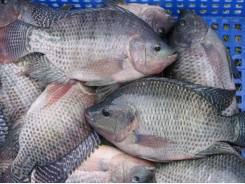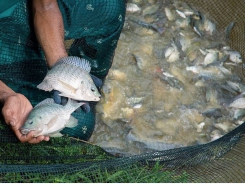Specific chelated feed additives may boost fish gut health

Adding amounts of propionate chelated to calcium may improve gut health and support liver function in farmed silver catfish, say researchers.
A team of researchers from the Company of Agricultural Research and Rural Extension of Santa Catarina (EPAGRI) and the Federal University of Santa Catarina explored the use of chelating ions and organic acid salts in the diets of silver catfish.
“Little information is known regarding the effect of different chelating ions of organic acid salts on intestinal health,” the researchers said. “Therefore, the aim of this study was to evaluate the influence of calcium and sodium chelated to propionic acid on the digestive enzymes activities, intestinal microbial composition and histological alterations in the liver and intestine of silver catfish R. quelen.”
The researchers found that within the gastrointestinal tract (GIT) digestive enzymes activities were similar regardless of the chelating mineral used or the concentration to propionic acid. Fish receiving a diet with calcium (Ca) at 0.25% or sodium (Na) at 0.25% had the best histomorphometry parameters.
“The organic acid propionate chelated to calcium at 0.25% improved the microbial composition and intestinal health of silver catfish, with no effects on the liver, the most important organ for depuration, and could be indicated as a feed additive for silver catfish,” they added.
Raising silver catfish
Aquaculture production appears a promising way to generate farmed animal protein, the researchers said. In the industry, about 93.8% of the total fish production is generated by freshwater species.
However, more species and native fish are being added to production farms, they said.
In southern Brazil, the native species Rhamdia quelen or “jundiá” also knowns as the silver catfish is considered to have good zootechnical characteristics and is accepted in the market.
The silver catfish is one of the top three most important aquaculture species in Santa Catarina, following tilapia and carp, they said.
“There is a need for high-quality feed additives that provide better productive performance and disease resistance since silver catfish suffer from several bacterial and parasitic diseases."
Chelating minerals and antibiotic alternatives
Previously, producers used antibiotics as growth promoters however, that practice has been linked to meat contamination, environmental pollution and the spread of plasmids with antibiotic resistance among microorganisms, the researchers said.
Antibiotic use as a growth promoter also may disrupt microbial communities and cause oxidative stress, and the practice has been stopped in several countries.
However, reducing reliance on antibiotic use prompts the search for “biosecure substances that are capable of inducing improvements” in farmed species, they said.
Organic acid salts are commonly used in swine and poultry production.
“Organic acid salts are short-chain fatty acids that become stable when they are chelated to minerals, for example, calcium (Ca+2), potassium (K+1) and sodium (Na+1); as a consequence, they become organic acid salts,” the researchers added. “The most sought-after organic acid salts are potassium or sodium formate, calcium or sodium propionate, and sodium butyrate.”
Several organic acid salts along with respective chelating minerals have demonstrated effectiveness in some aquaculture species, they said. Different salts have been determined to alter parameters including productivity, disease resistance, immune system function, nutrition and digestive enzyme activity along with the intestinal microbiota composition.
In shrimp, 2% sodium propionate was found to inhibit vibrios and sodium acetate and propionate were linked to increased activity of trypsin and chymotrypsin, they said. “The addition of citrate acid, calcium lactate and potassium formate to the diet of red drum, Sciaenops ocellatus, improved both pancreatic (trypsin and lipase) and intestinal enzymes (leucine-aminopeptidase and phosphatases), compared to unsupplemented fish,” they added.
However, there is little information regarding the role that the chelating mineral plays in determining the effects of organic acids on the overall health or the intestinal health in farmed species, they said.
Feeding trial details
In the feeding trial, 225 fish received one of five diets for a 60-day period, the researchers said. The feeds included a corn bran and soybean meal-based control and diets with varying levels of either organic propionic acid chelated with calcium or sodium at 0.25% or 1%.
Fish were weighed every 15 days, they said. Select fish were harvested on day 60 for posterior enzymatic analysis and the GIT of sample fish also were collected.
Lipase activity, amylase activity, acid protease activity and alkaline protease activity were noted, they said. Fish intestines also were gathered for microbial analysis and portions of the intestine and liver were examined.
Results
At the end of the feeding trial, digestive enzyme activity was similar for fish on all of the diets, the researchers said. “The activities of the enzymes quantified in the GIT of silver catfish, in descending order, were lipase, acid protease, amylase and alkaline protease,” they added.
“We verified that the mineral chelator influences intestinal health,” they said. “Calcium chelated to propionic acid at the lowest concentration (0.25%) presented a better composition of the cultivable microbiota (lower concentration of total heterotrophic bacteria and higher lactic acid count), compared to the group supplemented with Na1%, as well as better maintenance of the appearance cord and less observation of foci of cholestasis.”
“However, the chelating mineral is not the only aspect to act on intestinal health, but so does the concentration of the active principle, such as propionic acid,” they added. “Fish fed a diet with a lower concentration of propionic acid (0.25%), independent of the chelating mineral (Ca+2 or Na+1), had better histomorphometric parameters.”
Fish receiving diets with propionate chelated with calcium had lower total counts of heterotrophic bacteria compared to those on the control or sodium diets, the researchers said. Fish with the highest counts of total lactic acid bacteria were those on the Ca 0.25% and Na 0.25% diets.
“Regarding the histological alterations in the liver, fish supplemented Ca0.25% showed a greater maintenance of the cordonal aspect in comparison with the control group,” they said.
“After 60 days of culture, it was observed that the intestine of the fish supplemented with propionate independent of the chelating mineral at the lowest concentrations (Ca0.25% and Na0.25%) had the best values of villi width, number of villi, and lower concentrations of eosinophilic and lymphocytic infiltrates compared to animals supplemented with propionates at the highest concentrations independent of the chelator (Ca1% and Na1%),” they added.
Only fish on the Ca 0.25% diet were found to have some bacteria that were “morphologically bacillus,” the researchers said.
“We can conclude that the mineral chelating to organic acid tested influences fish intestinal health,” they said. “The organic salt propionate chelated to the mineral calcium or sodium at a concentration of 0.25% improved the microbial composition and intestinal health of silver catfish, without degrading the functions and morphology of the main purification organ, the liver.”
Source: Aquaculture
Authors: S. Pereira, G. Jesus, L. Cardoso, B. Silva, J. Ferrarezi, T. Ferreira, F. Sterzelecki, J. Sugai, M. Martins, J. Mouriño
Related news
Tools

Phối trộn thức ăn chăn nuôi

Pha dung dịch thủy canh

Định mức cho tôm ăn

Phối trộn phân bón NPK

Xác định tỷ lệ tôm sống

Chuyển đổi đơn vị phân bón

Xác định công suất sục khí

Chuyển đổi đơn vị tôm

Tính diện tích nhà kính

Tính thể tích ao




 Minty feed may boost tilapia survival during disease…
Minty feed may boost tilapia survival during disease…  Streptococcus vaccine offers hope for tilapia sector
Streptococcus vaccine offers hope for tilapia sector